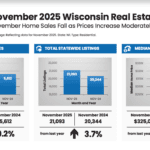NOTE: Wisconsin elections data guru Joe Handrick provided Dairyland Sentinel with this analysis of early voting through the end of last week. We’ll have more from Handrick in the coming days, and he can be followed on X where his handle is @joeminocqua.
Early in-person voting continues to be strong across the Badger state. After five days of in-person voting (Tuesday through Saturday), more than 405,000 people have voted in-person — a 43% increase over the same point in 2020.
Mail in voting continues to lag far behind 2020, however. 2020 saw a drastic spike in mail voting due to the pandemic. Mail ballots received as of the end of five days of in-person voting is down 58% compared to 2020.
When the two forms of early voting are combined, just over 850,000 ballots have been cast so far in 2024. That number is 36% less than at the same point in 2020.
Using 3.33 million as the mark for total votes expected in Wisconsin in 2024, this means that 26% of expected voters have already cast ballots. Unlike many states that have voters register by party, it is not possible to know in Wisconsin the balance of that early vote cast by Republicans, Democrats and Independents.
We can, however, examine how the votes are coming in at the county and/or municipal level.
Below is a chart showing the top 12 and bottom 12 counties in terms of votes cast to date compared to the expected total vote for each county.
The three WOW counties lead the way, followed by deep blue Dane County. Note, however, that it’s not “red or blue” dictating the top dozen — it is the size of the county.
The top 12 counties are all larger (by population) counties including very red counties (e.g. Washington), very blue (e.g. Dane) counties, and the big swing counties (Brown, Outagamie, Racine, Kenosha, and Winnebago).
The bottom dozen are all primarily rural counties. This is not surprising as election day voting is still the preferred method for many rural voters (even as early in-person voting is increasing in rural towns – SEE next chart). Urban areas have long had more voters cast ballots early to avoid the long lines that are typically not found in small towns.
The leftward columns in the following chart shows four examples of how in-person voting is increasing in rural areas. Take note of how the in-person change from 2020 varies widely. This wide variation is not just in the rurals, but also in the four cities and the four suburbs listed (Eau Claire has actually seen a slight decrease).
As stated earlier, in-person voting is up statewide by 43% over the same time in 2020. Note that 3 of the 4 rural towns listed below are well over that mark as are 3 of the 4 suburbs. Meanwhile 3 of the 4 cities are below the 43% mark. The exception is Madison which is up 104% in terms of in-person voting (but down sharply in terms of mail ballots).
Moving back to county level data, how are the WOW counties stacking up compared to super-blue Dane and Milwaukee? The answer appears to be, “pretty well” so far.
All five counties are seeing increases in in-person voting and decreases in mail voting (again, not surprising compared to the pandemic election). The WOW counties are doing modestly better in terms of the total early vote. Dane and Milwaukee are down 41 and 43% respectively compared to 2020. The WOW counties are down by smaller percentages.
The chart below details those changes. As a share of the state’s total early vote, the Dane/Milwaukee share is down 2% while the WOW share is up 3%.
Summary – The top 3 trends so far are:
- As they have in the past, larger counties (of all political stripes) are leading in terms of the share of the total expected vote that has already been cast, but rural areas and suburbs are generally seeing larger percentage increases in in-person early voting over 2020 than are the cities.
- When in-person and mail ballots are combined, cities are generally seeing a larger decrease compared to 2020 than are rural areas and suburbs
- The WOW share of the statewide early vote is up, the Dane/Milwaukee share of the early vote is down.
…











